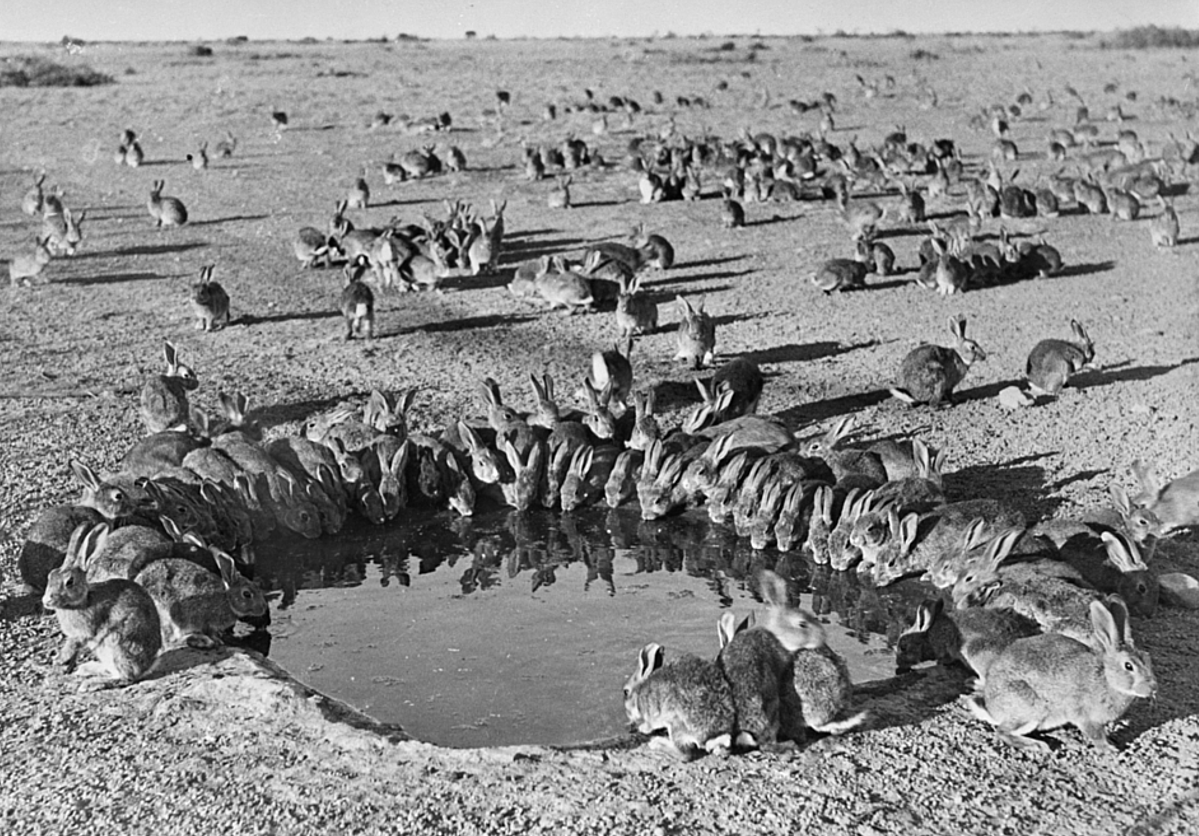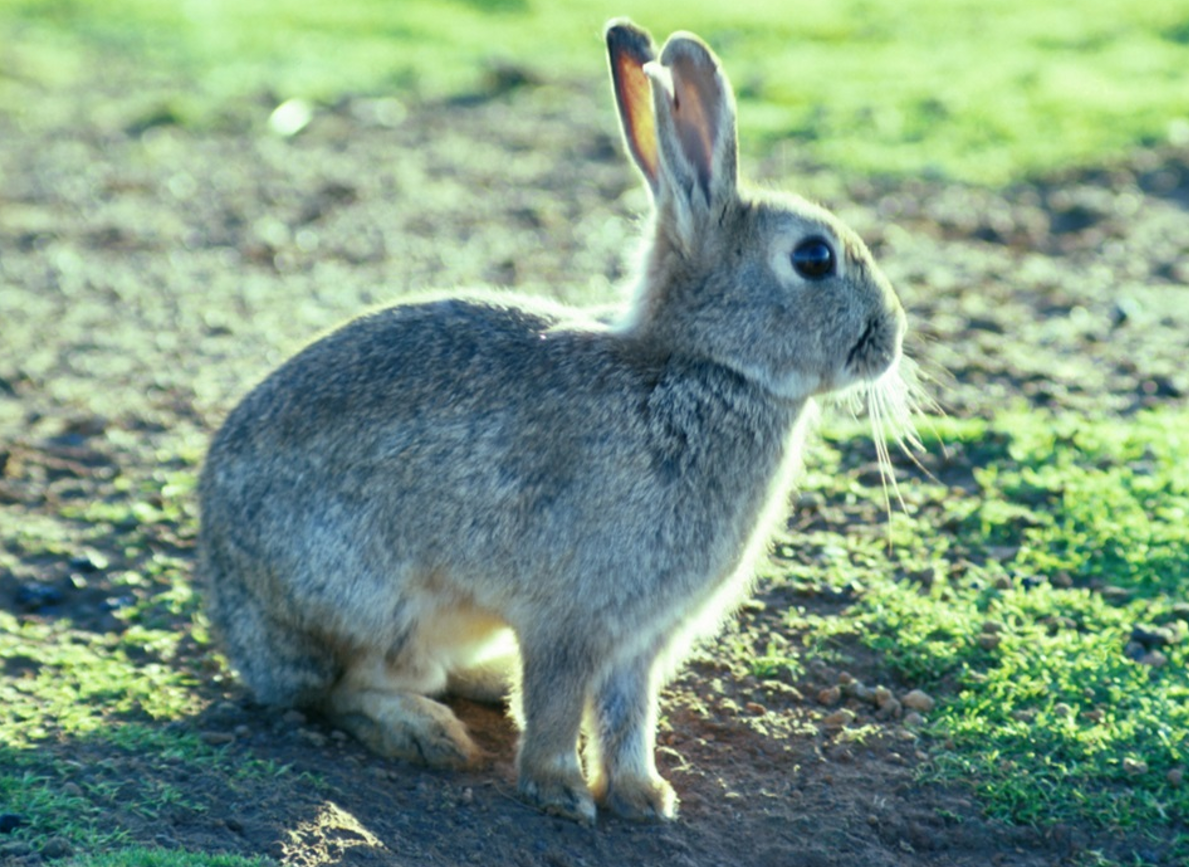A growing problem

Rabbits were introduced to Australia in 1859 by a wealthy Victorian grazier keen on the sport of hunting. After a fire destroyed the enclosures, rabbits started their campaign to conquer Australia. Within 70 years they spread to 70 per cent of Australia's landmass, the fastest known invasion by a mammal anywhere in the world. The damage caused by rabbits ranged from massive grazing pressure and competition with livestock to spreading weeds and accelerating erosion, and many farms were abandoned during the peak of the rabbit plaque.
Even today, with rabbit numbers still at a fraction of pre-Myxomatosis levels, rabbits cause an estimated AUD$200 million per year of economic damage, in addition to countless detrimental effects on biodiversity. Due to their selective grazing habits, less than one rabbit per hectare can completely prevent the regeneration of certain native tree and shrub species that are palatable to rabbits.
Biocontrol with viruses
We released myxomatosis in 1950. It was the world's first successful biological control program of a mammalian pest, taming a scourge that had threatened Australian agriculture and environment. However, by the late 1950s, host-pathogen co-evolution led to a less severe form of the disease, and rabbit numbers increased again, although not to pre-1950 levels.
In 1996 Rabbit Haemorrhagic Disease Virus (RHDV), a calicivirus, was officially released in Australia. RHDV again reduced rabbit numbers to very low levels, with greatest impact in arid zones and lesser impact in high rainfall areas.
RHDV kept rabbit numbers low for over a decade and, unlike Myxomavirus, a reduction in virulence has so far not been observed. However, evidence for developing resistance in some Australian wild rabbit populations has now been described, and rabbit numbers are again on the rise.
In 2015 we identified an additional strain of calicivirus, termed RHDV2, in Australia. Within 18 months RHDV2 spread across the entire continent and became the dominant RHDV strain in Australia, leading to an estimated reduction of 60 per cent on average of wild rabbit populations.
An ongoing battle
Biological control is by far the most cost effective large-scale control option for rabbits. Keeping their numbers low over long periods of time is essential for Australia's biodiversity and rural industries. Current research aims to help the virus stay ahead in the co-evolutionary arms race with its rabbit host, to protect the gains made by the past successful biocontrol initiatives and to keep rabbit numbers below the damage threshold.
Myxomatosis and RHDV show that following the initial impact of a new biocontrol agent, rabbit numbers eventually bounce back again. It highlights the need to never solely rely on biological control to manage pest rabbits, but to always combine it with conventional control methods.
CSIRO currently leads and participates in a series of collaborative projects funded by the Centre for Invasive Species Solutions (CISS) and Meat and Livestock Australia (MLA).
We are investigating how the different caliciviruses in Australia can be applied in a more strategic manner to maximise the outcome of rabbit biocontrol operations and further reduce rabbit impacts to agriculture and environment. Through these projects, ongoing rabbit disease monitoring by CSIRO's team continues to provide critical data which is fed into a publicly available and continually updated rabbit calicivirus map of Australia, and provides information about which viruses are circulating, where they are circulating and when they are circulating. This map helps land managers in the development, coordination and timing of tailored rabbit management strategies, and aids veterinarians and pet rabbit owners in implementing biosecurity measures and, where available, vaccination strategies to protect non-target domestic rabbits.
A second line of research is investigating the development of a platform technology to accelerate and direct the natural evolution of the virus. The ultimate goal of this non-GMO approach is to repeatedly select tailored virus strains for subsequent virus releases, giving the virus the cutting edge to stay ahead in the co-evolutionary arms race with its host. To this end, the Team is investigating the use of rabbit organoid systems (3D cell culture systems that mimic miniature organs) for growing and studying rabbit caliciviruses in vivo.
Other lines of current research include searching for new and unrecognised viruses of rabbits and hares in Australia, that may be important as zoonotic pathogens (posing a risk to people), future potential biocontrol agents, or interfere with existing biocontrol viruses.
Novel emerging genetic technologies are opening up new opportunities for targeted genetic biocontrol options, for example by causing infertility or skewing the sex ratio of pest animal populations that could lead to population crashes. This rapidly developing field of science may well provide exciting new opportunities for more humane landscape scale rabbit control in the future, provided safety and efficacy can be demonstrated.
A growing problem
Rabbits were introduced to Australia in 1859 by a wealthy Victorian grazier keen on the sport of hunting. After a fire destroyed the enclosures, rabbits started their campaign to conquer Australia. Within 70 years they spread to 70 per cent of Australia's landmass, the fastest known invasion by a mammal anywhere in the world. The damage caused by rabbits ranged from massive grazing pressure and competition with livestock to spreading weeds and accelerating erosion, and many farms were abandoned during the peak of the rabbit plaque.
Even today, with rabbit numbers still at a fraction of pre-Myxomatosis levels, rabbits cause an estimated AUD$200 million per year of economic damage, in addition to countless detrimental effects on biodiversity. Due to their selective grazing habits, less than one rabbit per hectare can completely prevent the regeneration of certain native tree and shrub species that are palatable to rabbits.
Biocontrol with viruses
We released myxomatosis in 1950. It was the world's first successful biological control program of a mammalian pest, taming a scourge that had threatened Australian agriculture and environment. However, by the late 1950s, host-pathogen co-evolution led to a less severe form of the disease, and rabbit numbers increased again, although not to pre-1950 levels.
In 1996 Rabbit Haemorrhagic Disease Virus (RHDV), a calicivirus, was officially released in Australia. RHDV again reduced rabbit numbers to very low levels, with greatest impact in arid zones and lesser impact in high rainfall areas.
RHDV kept rabbit numbers low for over a decade and, unlike Myxomavirus, a reduction in virulence has so far not been observed. However, evidence for developing resistance in some Australian wild rabbit populations has now been described, and rabbit numbers are again on the rise.
In 2015 we identified an additional strain of calicivirus, termed RHDV2, in Australia. Within 18 months RHDV2 spread across the entire continent and became the dominant RHDV strain in Australia, leading to an estimated reduction of 60 per cent on average of wild rabbit populations.
An ongoing battle
Biological control is by far the most cost effective large-scale control option for rabbits. Keeping their numbers low over long periods of time is essential for Australia's biodiversity and rural industries. Current research aims to help the virus stay ahead in the co-evolutionary arms race with its rabbit host, to protect the gains made by the past successful biocontrol initiatives and to keep rabbit numbers below the damage threshold.
Myxomatosis and RHDV show that following the initial impact of a new biocontrol agent, rabbit numbers eventually bounce back again. It highlights the need to never solely rely on biological control to manage pest rabbits, but to always combine it with conventional control methods.
CSIRO currently leads and participates in a series of collaborative projects funded by the Centre for Invasive Species Solutions (CISS) and Meat and Livestock Australia (MLA).
We are investigating how the different caliciviruses in Australia can be applied in a more strategic manner to maximise the outcome of rabbit biocontrol operations and further reduce rabbit impacts to agriculture and environment. Through these projects, ongoing rabbit disease monitoring by CSIRO's team continues to provide critical data which is fed into a publicly available and continually updated rabbit calicivirus map of Australia, and provides information about which viruses are circulating, where they are circulating and when they are circulating. This map helps land managers in the development, coordination and timing of tailored rabbit management strategies, and aids veterinarians and pet rabbit owners in implementing biosecurity measures and, where available, vaccination strategies to protect non-target domestic rabbits.
A second line of research is investigating the development of a platform technology to accelerate and direct the natural evolution of the virus. The ultimate goal of this non-GMO approach is to repeatedly select tailored virus strains for subsequent virus releases, giving the virus the cutting edge to stay ahead in the co-evolutionary arms race with its host. To this end, the Team is investigating the use of rabbit organoid systems (3D cell culture systems that mimic miniature organs) for growing and studying rabbit caliciviruses in vivo.
Other lines of current research include searching for new and unrecognised viruses of rabbits and hares in Australia, that may be important as zoonotic pathogens (posing a risk to people), future potential biocontrol agents, or interfere with existing biocontrol viruses.
Novel emerging genetic technologies are opening up new opportunities for targeted genetic biocontrol options, for example by causing infertility or skewing the sex ratio of pest animal populations that could lead to population crashes. This rapidly developing field of science may well provide exciting new opportunities for more humane landscape scale rabbit control in the future, provided safety and efficacy can be demonstrated.

